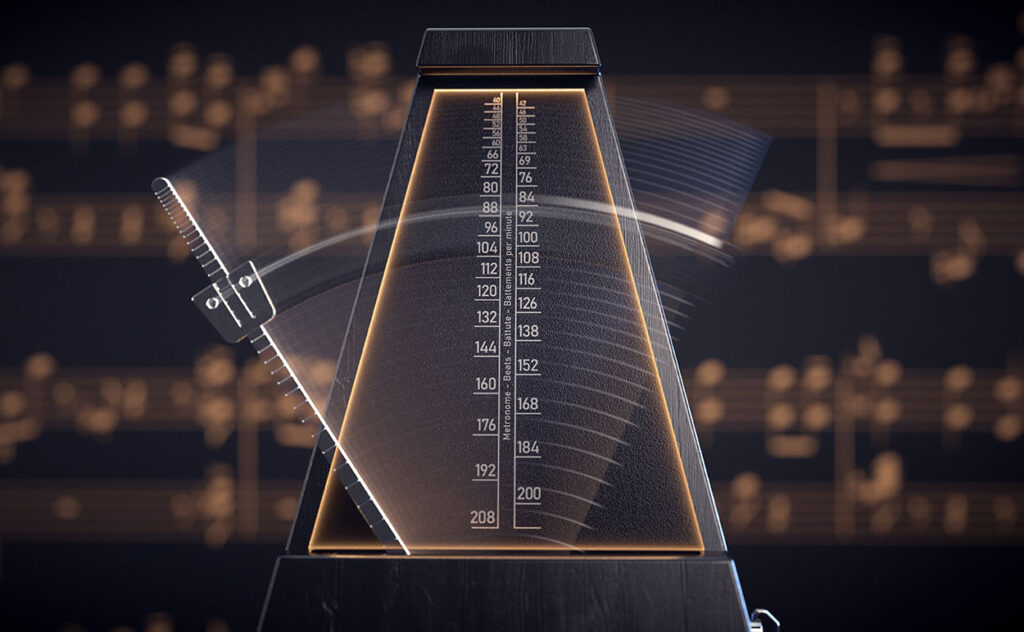Now that you understand the basics of time signatures and note values, you have gained an important insight: Even if you know how many notes are in each bar - an essential element of musical notation - this does not tell you how fast those notes are actually being played. This is where the tempo indicator comes in.
The tempo of a piece of music determines how fast or slow it is played. For example, in a 4/4 time signature, the tempo determines how fast the four beats are played. It is therefore a kind of bridge that connects note values and bars to real time. The tempo gives a piece of music its specific dynamics and its own rhythm, and thus significantly influences its mood.
How do you measure the tempo?
The tempo can be specified in a number of ways - more on this later - but it is always measured in BPM (beats per minute). So a tempo of 120 BPM means that every second has two beats per minute.
The note value of a beat is determined by the denominator of the time signature. A 4/4 time signature means that each beat is a quarter note long, while a 3/8 time signature means that each beat is an eighth note long.
How is the tempo indicated in a song?
The tempo of a song is indicated differently depending on the context and situation - at a band rehearsal, the tempo is indicated differently than at a classical concert. Each situation also leaves more or less room for deviation - at a concert, it is acceptable for the tempo to fluctuate inadvertently during the song because the musicians are not using a metronome.

However, this is not acceptable for modern professional studio recordings, where the tempo must always be the same and must not fluctuate accidentally or unintentionally.
The following methods can be used to determine the tempo of a musical performance:
- Metronome indication: The most accurate way to indicate tempo is to use a metronome number. This number indicates the number of beats per minute (BPM). For example, "100 BPM" means there are 100 beats per minute. This method is commonly used in modern music and music production.
- Tempo markings: In classical music, and often in printed music, tempo is often indicated using Italian terms. These terms describe tempo in general terms and include words such as "lento" (very slow), "moderato" (moderate), "allegro" (fast), and "presto" (very fast). These are less precise than metronome markings and allow for slight variations, but give a general idea of the tempo.
- Modern notation software: In today's digital music production, the tempo is often specified directly in the notation software or the DAW (Digital Audio Workstation). The software makes it possible to specify the tempo in BPM and even change it during the piece.
Here is a table of Italian tempo indications and corresponding BPM ranges:
| Italian term | Meaning | BPM area |
|---|---|---|
| Larghissimo | Very, very slow | Under 20 BPM |
| Grave | Heavy, serious | 20-40 BPM |
| Lento | Slowly | 40-60 BPM |
| Largo | Broad | 40-60 BPM |
| Larghetto | Somewhat wide | 60-66 BPM |
| Adagio | Slowly, easily | 66-76 BPM |
| Adagietto | Slightly faster than Adagio | 70-80 BPM |
| Andante | Walking | 76-108 BPM |
| Andantino | Slightly faster than Andante | 80-108 BPM |
| Moderato | Moderate | 108-120 BPM |
| Allegretto | A little cheerful | 112-120 BPM |
| Allegro | Cheerful, fast | 120-168 BPM |
| Vivace | Lively | 168-176 BPM |
| Vivacissimo | Very lively | About 172 BPM |
| Allegrissimo | Very fast | About 172 BPM |
| Presto | Very fast | 168-200 BPM |
| Prestissimo | Extremely fast | Over 200 BPM |
Who sets the tempo?
Depending on the context, the tempo is indicated by one person or another. In classical music, the tempo is indicated by the conductor, who usually counts 1 or 2 bars with his hands so that all the musicians know the tempo before the piece begins.
In modern music, the drummer usually sets the tempo by counting off a bar or two with his sticks. All the other band members then follow the drummer. However, if the song begins with a solo, such as a vocal solo, the singer sets the tempo and everyone else follows.
When recording in a studio, a click track is usually created, which is nothing more than a digital metronome, and the musicians listen to this track during the recording so that they can play exactly on point. However, it is enough if the drummer only hears this track, because then all the other instruments can simply follow the drums.
Changes in tempo
In addition to the tempo markings on the music sheets, there are also markings for tempo changes. For example, if a piece starts fast but slows down in the middle, it will say "ritardando", which means "slowing down" in Italian. These are the 4 most common tempo markings within a piece:
- Accelerando (accel.): A progressive increase in tempo. This instruction is used to speed up the piece and increase the intensity or excitement.
- Ritardando (rit.): A progressive slowing of tempo. Ritardando is used to slow down the tempo, often at the end of a piece or section of music, to reduce tension or introduce a quieter section.
- A Tempo: Return to the original or previous tempo after a tempo change. This command is used to restore the normal tempo.
- Fermata (holding sheet): A symbol indicating that a note or pause should be held longer than its note value indicates. A fermata allows a note or pause to last longer than its normal duration, and is often used to create a dramatic effect or to end a section. The tempo of the piece is therefore changed only for that note.
Examples of different tempi
To illustrate this, the same section of the song is played below at different tempos to emphasize the different effects.
















